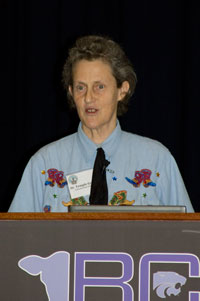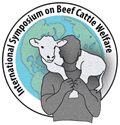Auditing Animal Welfare
MANHATTAN, Kan. (May 19, 2010) — According to Temple Grandin, Colorado State University animal behaviorist and welfare specialist, the beef industry does a lot of things right. That doesn’t mean there is no room to improve the way cattle are handled. During the International Symposium on Beef Cattle Welfare, hosted by Kansas State University, Grandin urged livestock producers to implement on-farm auditing systems to maintain high standards in cattle handling.

Cattlemen can evaluate cattle welfare using objective, measurable factors like body condition score, lameness, coat condition, etc., says animal handling expert Temple Grandin.
Grandin helped the meat packing industry implement auditing systems for harvest facilities, creating a numerical scoring system by which packers could evaluate and fine-tune their practices. Packer cattle handling audits typically evaluate stunning procedures, frequency at which cattle prods are used, rates at which cattle vocalize as an expression of distress, and rates at which cattle slip and fall. Cattle producers could audit their own methods and procedures to similarly reduce stress and potential injury to cattle.
“It prevents bad (practices) from becoming normal,” Grandin explained, noting how adequately trained handlers backslide, falling into old habits.
Grandin said audits should assign scores to simple things that can be measured on an outcome basis. She advised producers to avoid ambiguity when setting standards for cattle handling. Standards defined as proper, sufficient or adequate are open to too much interpretation. Guidelines, she said, should be clearly stated.
Grandin said outcome measures that could be monitored through on-farm audits include body condition score, hair coat condition and cleanliness, animal lameness and injuries, ammonia levels in confinement housing and abnormal animal behaviors.
“Measure a small number of critical control points — the really important things that can be directly observed. Do it on a regular basis,” Grandin advised.
Through vigilance, she said, producers can use audits to evaluate the results of their handling practices, identify areas where changes are needed and measure whether changes result in improvement.
The beef cattle welfare symposium was conducted on campus at K-State University May 19-21. For additional presentation summaries, return to the Meetings > Other Industry Meetings > News Coverage page of the API Virtual Library. For more about the symposium and an archive to the 2008 symposium, visit www.isbcw.beefcattleinstitute.org.
Editor's Note: This article was written under contract or by staff of Angus Productions Inc. (API), which claims copyright to this article. It may not be published or distributed without the express permission of API. To request reprint permission and guidelines, contact Shauna Rose Hermel, editor, at 816-383-5270.

